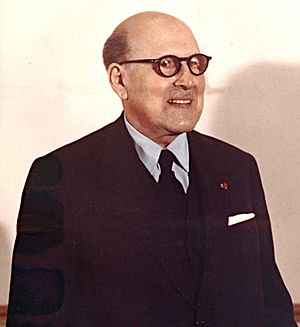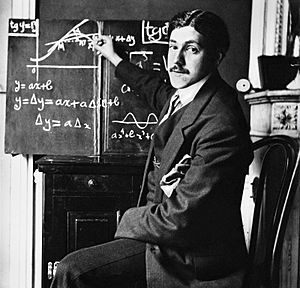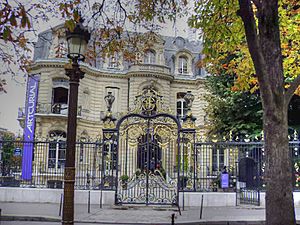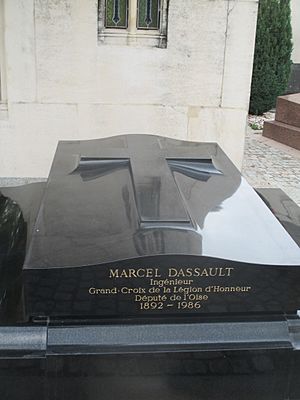Marcel Dassault facts for kids
Quick facts for kids
Marcel Dassault
|
|
|---|---|
 |
|
| Born |
Marcel Ferdinand Bloch
23 January 1892 Paris, France
|
| Died | 17 April 1986 (aged 94) Neuilly-sur-Seine, France
|
| Resting place | Passy Cemetery, Paris |
| Education | Lycée Condorcet |
| Alma mater | Breguet School Supaéro |
| Occupation | Engineer and industrialist |
| Spouse(s) | Madeleine Minckes |
| Children | Claude Dassault Serge Dassault |
| Relatives | Darius Paul Dassault (brother) |
| Awards | Daniel Guggenheim Medal (1976) |
Marcel Dassault (born Marcel Ferdinand Bloch) was a famous French engineer and businessman. He spent his whole working life building airplanes. He was born in Paris, France, on January 23, 1892, and passed away on April 17, 1986.
Contents
Marcel Dassault's Early Life and School
Marcel Bloch was born in Paris on January 23, 1892. He was the youngest of four children. His father, Adolphe Bloch, was a doctor. Marcel went to school at Lycée Condorcet in Paris.
He studied electrical engineering and then went to two special schools: the Breguet School and Supaéro. At Supaéro, one of his classmates was Mikhail Gurevich, a Russian student. Mikhail later helped create the famous MiG aircraft series.
Marcel Dassault's Career in Aviation
Starting in World War I
During World War I, Marcel Bloch worked at the French Aeronautics Research Laboratory. This was a place where new flying ideas were tested. He invented a special kind of propeller for airplanes. The French army used his propeller during the war.
In 1916, Marcel Bloch teamed up with Henry Potez and Louis Coroller. They started a company called Société d'Études Aéronautiques. Their goal was to build a series of fighter planes known as the SEA.
Building His Own Aircraft Company
In 1928, Bloch started his own aircraft company, Société des Avions Marcel Bloch. The company built its first airplane in 1930. A few years later, in 1935, Bloch and Henry Potez bought another company called Société Aérienne Bordelaise (SAB).
In 1936, the French government took over many aircraft companies, including Bloch's. This is called nationalization. His company became the Société Nationale de Constructions Aéronautiques du Sud Ouest (SNCASO). Bloch agreed to help manage this new government-owned company.
Challenges During World War II
When Nazi Germany occupied France during World War II, France's aircraft industry almost stopped. Factories mostly built or fixed German planes. In October 1940, Marcel Bloch bravely refused to work with the German occupiers. Because of this, the French government at the time, known as Vichy France, put him in prison.
In 1944, the Nazis sent Bloch to the Buchenwald concentration camp. This was a punishment because he would not cooperate with their rules. He was held there until the camp was freed on April 11, 1945. When he returned to Paris, he was very weak and could barely walk. Doctors thought he might not get better.
A New Name and New Beginnings
After the war, Marcel Bloch changed his name. First, he became Bloch-Dassault, and then in 1949, he officially became Marcel Dassault. The name "Dassault" came from his brother, General Darius Paul Bloch. His brother used "Dassault" as his secret code name, or nom de guerre, when he was fighting in the French Resistance. The name "Dassault" comes from the French words char d'assault, which means "tank."
In 1971, Dassault's company bought another aircraft company called Breguet. This created a new company named Avions Marcel Dassault–Breguet Aviation (AMD–BA).
Marcel Dassault's Personal Life
In 1919, Marcel Bloch married Madeleine Minckes. Her family was wealthy and sold furniture. Marcel and Madeleine had two sons, Claude and Serge. After changing his name to Dassault, he became a member of the Roman Catholic Church in 1950.
In 1952, Dassault bought two famous buildings in Paris called Hôtel Marcel Dassault. These buildings were built in 1844. Today, one of the buildings (number 7) is used by an auction house called Artcurial. The other building (number 9) is still used by the Groupe Industriel Marcel Dassault, which is the company Marcel started.
In 1973, Marcel Dassault was honored by being added to the International Air & Space Hall of Fame. This recognizes people who have made big contributions to aviation and space.
Death and Lasting Legacy
Marcel Dassault passed away in Neuilly-sur-Seine in 1986. He was buried in the Passy Cemetery in Paris.
His younger son, Serge Dassault, became the leader of Avions Marcel Dassault. The company later changed its name to Groupe Industriel Marcel Dassault because it became involved in many different businesses. In 1990, the part of the company that built airplanes was renamed Dassault Aviation.
In 1991, a famous traffic circle in Paris, the rond-point des Champs-Elysées, was renamed the rond-point des Champs-Elysées-Marcel-Dassault to honor him.
See also
 In Spanish: Marcel Dassault para niños
In Spanish: Marcel Dassault para niños




